Variant Editions Checklist (RDA)
SCOPE
These guidelines may be applied to books (monographs-only) under the following categories. Source copy should be full-level.
| Item in hand | Source Copy |
| Later edition | Earlier edition |
| Earlier edition | Later edition |
| British, Canadian, etc. edition | American edition |
| American edition | British, Canadian, etc. edition |
| Translation | Original |
| Original | Translation |
In general, do not apply these guidelines if the source copy is for a reproduction or edition in a different format (your item is print; bib record is for an electronic or microform resource).
Typical record for the item in hand may be a brief record created in Orbis, an E/L 5 vendor record, or an MLC record created by LC or a member library. Full cataloging unavailable from OCLC for the item in hand.
Statistics: count as original
Techniques
a. If the source record is in Orbis, tile the record being cataloged and the source record and then copy and paste the relevant fields from the source record to the record being cataloged.
b. If the source record is only in OCLC, export the record and then overlay the record to be cataloged, then edit the overlaid record to match the item in hand. In that case, particular care must be made to update the 008 fields and delete inapplicable variable fields carried over from the source record.
c. If the source record is in Orbis, use the Voyager copy command to make a copy of the source record and use the copy record to overlay the record to be cataloged, then edit the overlaid record to match the item in hand. This method must be used with great care, or a duplicate record will load into Orbis instead of overlaying the record to be updated. Unless you are familiar with the use of the copy command procedures, do not use this technique.
Checklist
1. Leader:
Encoding level should be: blank if created in Orbis; I if created in OCLC.
Cataloging Form should be: i [ISBD] not a [AACR2]
2. 008. Be sure to change the date to match the publication date of your edition.
Make sure the Leader and Fixed Fields match the item being cataloged, especially if techniques b. or c. were used.
2. Typical fields that need to be deleted if source copy is used to overlay the record to be cataloged, or if vendor copy is being upgraded:
010, 029, 035, 045, 049, 082, 653, 9xx.
Note that the 035 for the OCLC source record should be deleted if you overlay variant edition copy on your in-process record. If the 035 for the OCLC source applies to a record you are updating manually, retain it.
3. Typical fields that need to be changed if source copy is used to overlay the record to be cataloged:
020: should be edited to match the item in hand
040: should be modified to: CtY ‡b eng ‡e rda ‡c CtY
050: if the source copy was LC, change the 050 indicators from 00 to _4 & change the call number date. CAUTION: If the copy is old, the classification may be obsolete. Current classification should be used.
090: if there is both a 050 and a 090, delete the 090. If there is no 050, re-tag the 090 to 050 _4, assuming the number is really LC classification.
Keep in mind that you may need to derive the call number you actually assign in the MFHD from editions already cataloged in Orbis, and not the 050/090 used in the source record.
4. Transcription & descriptive information.
245. Edit the 245 to match the item in hand. In the statement of responsibility, transcribe all names; the AACR2 "rule of 3" does not apply to RDA cataloging; include titles if they appear with the name: Professor Jane Jones, University of Connecticut.
1xx. Continue to enter under title if the book is a collection of essays. If the book is a collaboration, enter under the first named author even if there are more than 3. All authors should have the relationship designator "author": Jones, Jane, ‡e author -- Smith, Joan, ‡d 1949- ‡e author. Precede ‡e with a comma unless there is a hyphen. If the record uses 110 or 111, main entry choice does not change.
250. Add or edit the 250 to match the item in hand. Transcribe the edition statement as found, e.g., only abbreviate edition if it is actually abbreviated in the book. The edition statement should always end with a period.
260-->264. If the source copy has used 260, change it to 264 _1.
- Edit the place of publication to represent place name as found. If the larger jurisdiction in the place of publication is in brackets, spell out the place-name; do not abbreviate. If the source copy uses abbreviations, spell out the word if it is spelled out on the book, abbreviate if the word is abbreviated on the book. If there is more than one place, transcribe the first place only.
- Edit the publisher name to represent the publisher name as found. Include hierarchy if the corporate hierarchy is used in the book. Use abbreviations only if they are used in the book. Do not transcribe distributor statements.
- If the book only has a copyright date, enter it in brackets without the copyright "c." If the date is given in roman numerals, transcribe the date in roman numerals
- If the book lacks place of publication, publisher name, or any date, consult with your supervisor. Do not use [S.l.], [s.n.], or [n.d.]
300 checklist:
- Do not use abbreviations with the exception of "in." (i.e., you should use "pages," "illustrations," "color")
- Use unnumbered rather than brackets, e.g. 300 __ ‡a 300 pages, 3 unnumbered leaves of plates ...
- Do not use a period with cm
If the record lacks 336, 337, 338, be sure to enter them. Use of a macro is recommended.
4xx/8xx. Original series may not be present, so be sure not to add it to the record being cataloged if it is not on the item. If a new series is on the item, transcribe it as it appears. Use Staff Title to check Orbis for the established form. If the series has not been established, consult with your supervisor. Remember that under current practice, the ISSN of the series is entered as the last subfield in 830 (‡x)
5xx. Review the notes in the source record for relevance to the record being cataloged. For example, check the number of pages cited in Includes bibliographical references against the book in hand. If the last or first page of a range is unnumbered, supply the number but do not bracket it (or use "unnumbered").
700. Editors continue to be entered in 700. The relationship designator should be: ‡e editor of compilation. Authors (collaborations): if there are 3 or more authors, enter the first named in 100 and enter the next two authors in 700 with the relationship designator ‡e author. We will not generally be making more than two added entries for multiple author situations.
If you have to key in additional information, remember that diacritics are now entered after the character modified, not before.
6. Headings.
Use the current authorized form. When working with a later edition or a translation, keep in mind that an obsolete form may have been used on the source record.
Watch out for names appearing on the source copy that do not appear on the item cataloged. These names should not be traced in the record for the book you are cataloging.
Watch out for names appearing on the item cataloged that do not appear on the source copy. Decide whether any of the names need to be traced. If the new name represents a person who has contributed a substantial amount of content, the new name should be traced. If a new name needs to be traced, verify the currently authorized form. If there is no NAR, verify that the heading follows current AACR2/LCRI rules for form of entry. Watch out for variant forms of the person's name in Orbis. If the name needs references, have the name established by a cataloger with NACO authorization.
Subjects. If the source copy is old, the subject or the subdivision practice may be obsolete. Current practice should always be used. TIP: if the subject string does not match when saving the record, search in LC Online Catalog. If very few headings are retrieved, consult with a subject specialist.
7. Miscellaneous.
Arrange the variable fields in MARC or AACR2 order if necessary.
EXAMPLES
1. "Originalausg." in OCLC; "12. Auflage" in Orbis to be cataloged. (Märchen von starken Frauen)
2. 1944 reprint in Orbis with LC cataloging source; 2002 reprint in Orbis to be cataloged (vendor record), different series and publisher. (Diálogos militares)
3. Vendor record for translation in Orbis with LC cataloging for reprints of the original work in OCLC. Complex series involved. (La croisière de la "Janet Nichol")
Variant Editions>Example 1: Later Edition
Background: brief record in Orbis. Overlaid with source copy from OCLC; source copy edited to match item in hand.
Source copy:
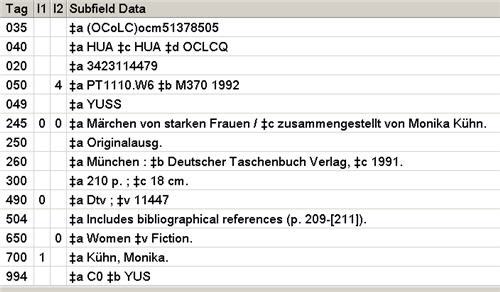
Record to be cataloged (before):
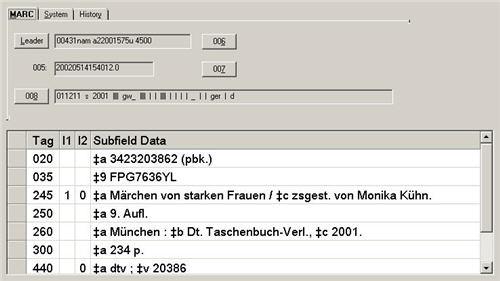
Cataloged Record (after):
Following overlay of the source record & editing to match the item cataloged.
Leader (Orbis record). Note Cataloging Form value is i.
008. Be sure to change the date to match the new publication date in 264.
Variable Fields (see comments following the picture).
Comments:
020 changes for the new edition.
035 for the old NOTIS number retained. All other 035 fields have been deleted.
In 040, $b eng represents the language of the cataloging agency, and $e rda is the only explicit identifier for the descriptive rules.
Auflage could represent printing or edition, but difference in pagination justifies treatment as a different edition; the word is not abbreviated in this edition. On the other hand, "12." appeared as such in the book.
In 300, "pages" and "page" are not abbreviated. Instead of brackets, "unnumbered" is used. No period with "cm," even if it is the last term in the field.
336-338 were supplied with a macro to minimize typos.
Last numbered page is 234; an additional page is added to justify the page numbering for the bibliographic references in 504. Although the last page of the bibliography is unnumbered, the page number is supplied without brackets.
Monika Kühn is new to Orbis. No NAR exists for her name in LC Authorities. No references are required; a name authority record is not created in this situation.
Although DTV 20386 appears on the item, the Series authority record (SAR) for DTV (Series) is coded c: Series like phrase under 008 Type of Series, so DTV 20386 should not be entered in 4xx. In addition, the 667 in the SAR indicates that DTV should not be included as a note either.
SAR Variable Fields:
Field 667 indicates that the cataloger should not use "DTV" in a note field. TIP: series authority records for series-like phrases will lack fields 642, 644, 645, & 646.
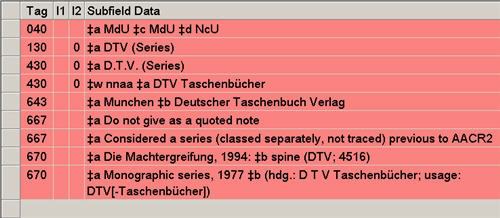
SAR 008:
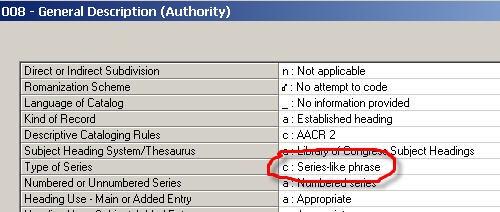
Variant Editions>Example 2: Reprint Edition (Vendor Record)
Background. Source copy is in Orbis, an LC record from the 40's created by RECON. No usable cataloging copy in OCLC. Book in hand has a vendor record in Orbis.
Source copy:
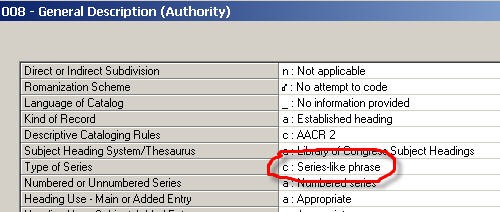
Record to be cataloged:
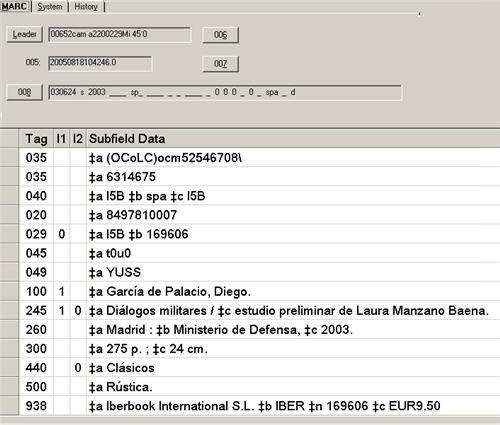
Post-editing:
Comments:
Because the source copy uses pre-ISBD punctuation and the vendor has supplied basic description using ISBD, a better technique in this case is to edit the record for the new edition directly rather than use copy and paste or the Voyager copy command.
Variable fields are deleted from the vendor record: 035 6314675, 029, 045, 500, and 938.
In 040 the $b in the vendor record indicates it was created by a non-English language cataloging agency. Since we do not want our record to set its holdings on the Spanish-language master record, delete the 035 for the OCLC id number and replace the 040 as indicated.
020 matches the book to be cataloged but was out of sequence; editing moves the field to follow MARC numerical order.
The 050 00 on the source record can't be used since it is a classed-together number for a different series. Since there are no other editions in Orbis or OCLC that have a classed separately, the number needs to be assigned by a cataloger who has authorization to use ClassWeb. The class number assigned correlates to other bibliographic records with primary subject Military art and science--Early works to 1800.
The authority record for Garcia de Palacio was recently upgraded to RDA form. The use of the fl. abbreviation is no longer used and is replaced with active. Current practice is to add a $e author relationship designator.
The 245 introduces the name Laura Manzano Baena which is not associated with the source bibliographic record. Note other differences between what was in the source record 245 and what is transcribed in the record for the book being cataloged. Note that the source record does not use ISBD punctuation, but the vendor has done so for field 245 and all of the other descriptive fields.
The vendor has not bracketed Madrid. The place of publication does not appear on the item, but can be inferred, so it is entered in brackets. CIP on the verso t.p. provides the information about the place of publication in bracketed form, and it seems reasonable to accept this.
However, the 2015 date of publication in the CIP is not reliable. Although there is a copyright date of 2014 on the verso t.p., there is actually no explicit publication date. The following appear on the verso t.p.: "Depósito Legal: M-19951-2014" and "Fecha de edición: abril 2015." Neither are considered publication dates (the latter is a printing date). A date (i.e. 2015) appearing in a CIP on the t.p. verso is not considered a publication date either. In current RDA cataloging (as interpreted by the LC-PCC policy statements), in the absence of a publication date the copyright date is used as the substitute, and is entered in brackets.
The publication date is recorded in 008 as Date Type s (single) Date/1 2014 Date 2/blank. This is a judgment call. The main text is a photocopy reprint of the 1583 publication but the substantial introduction can qualify it as a new edition rather than a Date Type r Date 1/2002 Date 2/1583. Items in this series are reprints; none of the titles were treated as reprints in 008 in other cataloged records.
Field 300 was edited to RDA standards; "pages" was spelled out, "illustrations" was added to subfield ‡b. The corresponding 008 field for illustrations has been updated.
The vendor has not transcribed the series correctly in 440 and has not used the authorized form. As the authority validation window indicates, the form used on the vendor record is a reference, not the established form of the series.
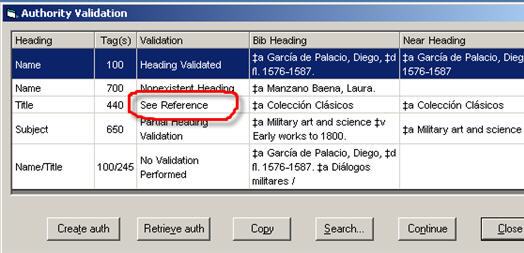
However, note that the reference is to a different series.
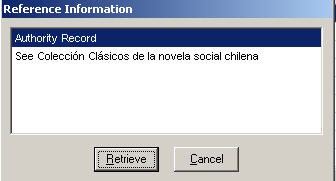
NOTE: since the reference might cause a problem with MARS processing, consult with a cataloger authorized to do NACO work in order to update the authority record for the other series.
Although the Voyager Authority Verification does not retrieve the series authority record for the series on your book, that does not mean your series has not been established. You will need to search further in Orbis.
A Staff Title search on "Colección Clásicos" retrieves 86 headings.
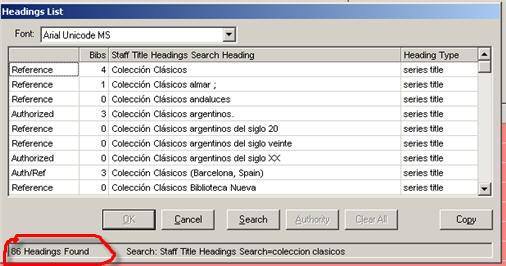
TIP: A quick way to find the series authority record is to use a "keyword in staff" search. Since there are many series beginning with "Colección Clásicos," the series is probably qualified. The qualifier is usually by place or publisher.
Here is a "keyword in staff" search using "Madrid" as the qualifier:
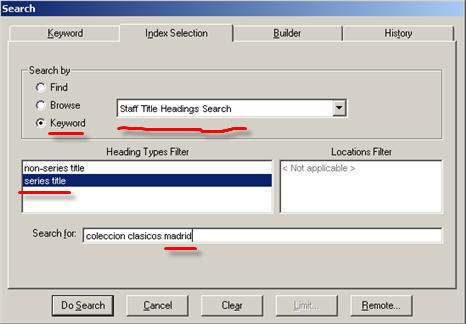
In this case, the Madrid qualifier has already been used for a different series:
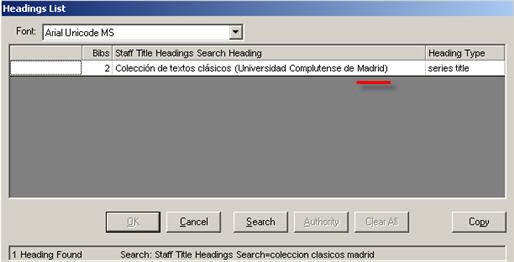
The other likely qualifier is the issuing body for the series. Since this is keyword searching, choose the least common term as the qualifier ("defensa") to reduce the number of records retrieved.
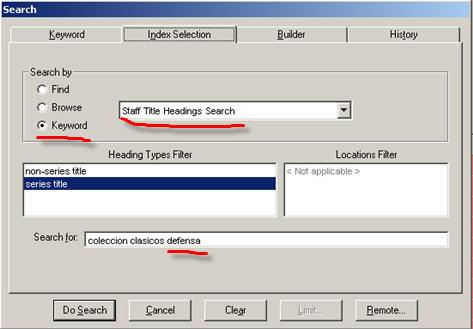
This retrieves the series authority needed:
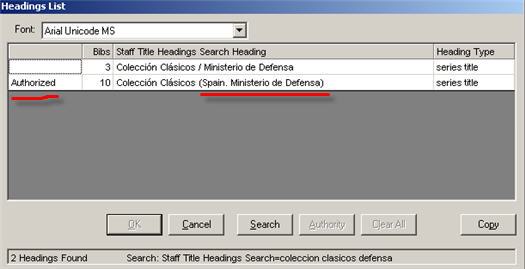
The authority record:
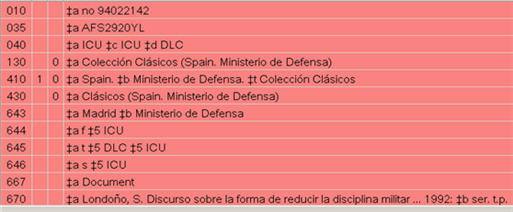
If no record had been found, you would then have had to do a regular "find" type Staff Title Search and scrolled through the headings until you identified the appropriate series heading.
Because the series requires a qualifier, it has to be recorded in 490 1/830 form. Copying and pasting from the Series Authority Record is recommended, especially since diacritics are involved.
The subject subdivision on the source record is obsolete, something to watch out for when using old cataloging. A subject browse search on Military art and science--To 1800 in LC Online Catalog retrieves only one record. A search on Military art and science--Early works to 1800 retrieves over 600 records. Note that the subdivision is coded ‡v. Have a cataloger with a Cataloger's Desktop authorization check the Free-floating subdivisions list if necessary.
Headings. Garcia de Palacio is established. A 700 for Laura Manzano Baena is justified based on a scholarly introduction that is 25% of the publication. No NAR has been made for Manzano Baena. Your unit may have guidelines on whether to make a NAR for compound surnames. YUL generally creates a NAR only when a reference is needed. In AACR2 a reference from the second surname was mandatory, but under current RDA and NACO guidelines, variant forms are not required. Authors of introductions are not assigned the relationship designator "author." There may be a suitable relationship designator for the writer of an introduction, but it is not mandatory.
Variant Editions>Example 3: Translation
Background. Item in hand is a translation. Source copy available cataloged by LC for the original. Orbis record for the item in hand is vendor copy. No cataloging available in OCLC for the translation.
Source copy:
LC cataloging is available in OCLC for 2 different editions, one published in 1914 and the other in 2004. Cataloging for the later edition is used as the source.
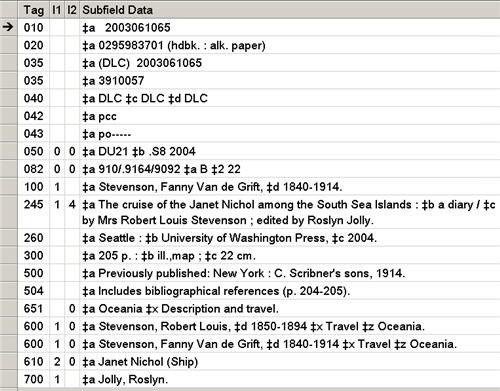
Orbis record:
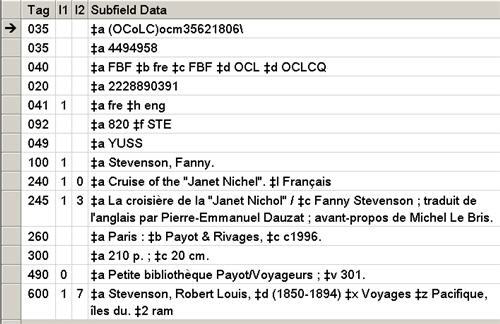
Updated version:
Best technique in this case would be to copy and paste the appropriate fields, then delete or update the fields in the vendor record.
| 020 | ‡a 2228890391 | ||
| 040 | ‡a CtY ‡b eng ‡e rda ‡c CtY | ||
| 041 | 1 | ‡a fre ‡h eng | |
| 043 | ‡a po----- | ||
| 050 | 4 | ‡a DU21 ‡b .S814 1996 | |
| 100 | 1 | ‡a Stevenson, Fanny Van de Grift, ‡d 1840-1914. | |
| 240 | 1 | 0 | ‡a Cruise of the "Janet Nichol" among the South Sea Islands. ‡l French |
| 245 | 1 | 3 | ‡a La croisière de la "Janet Nichol" / ‡c Fanny Stevenson ; traduit de l'anglais par Pierre-Emmanuel Dauzat ; avant-propos de Michel Le Bris. |
| 264 | 1 | ‡a Paris : ‡b Editions Payot & Rivages, ‡c [1996] | |
| 300 | ‡a 210 pages : ‡b map ; ‡c 20 cm | ||
| 336 | ‡a text ‡2 rdacontent | ||
| 337 | ‡a unmediated ‡2 rdamedia | ||
| 338 | ‡a volume ‡2 rdacarrier | ||
| 490 | 1 | ‡a Petite Bibliothèque Payot ; ‡v 301. ‡a Voyageurs | |
| 600 | 1 | 0 | ‡a Stevenson, Robert Louis, ‡d 1850-1894 ‡x Travel ‡z Oceania. |
| 600 | 1 | 0 | ‡a Stevenson, Fanny Van de Grift, ‡d 1840-1914 ‡x Travel ‡z Oceania. |
| 610 | 2 | 0 | ‡a Janet Nichol (Ship) |
| 830 | 0 | ‡a Petite Bibliothèque Payot. ‡p Voyageurs. |
Comments:
Fields deleted (from the vendor record): 035, 092, 049, 600 17.
Since ‡b fre indicates that this would be a parallel record in the OCLC database, delete all the 040 data and replace with CtY ‡b eng ‡e rda ‡c CtY. (OCLC policy requires a separate bibliographic record if the only record in the database was created by a non-English language cataloging agency; note that you have already deleted the 035 of the parallel vendor record.)
The 043 is copied from the source record.
The 050 is copied from the source record but the indicators are changed to indicate the number is not assigned by LC and the translation numbers for French are added to the book number; the call number date is also changed to match the publication date of the item in hand.
The form for the 100 field in the vendor record (Stevenson, Fanny) is not authorized and is replaced with the heading used on the LC record: Stevenson, Fanny van de Grift, 1840-1914. A check of the 040 in the authority record indicates the name is valid RDA form.
The 240 ‡a is modified to be consistent with the title proper used on the 2 LC records in OCLC. If a Name/Title authority record had been found, the title from the NAR would have been used. The 240 ‡l is changed to the English language form.
No changes are made to the vendor record 245, which uses current ISBD punctuation.
Field 260 __ was re-tagged to 264 _1; the vendor shortened the publisher statement by dropping Editions. Since RDA instructions are to transfer the full publisher name as found, the cataloger added Editions. The punctuation used by the vendor follows ISBD; no change to punctuation.
The 300 field is modified to record the illustration. Pages is spelled-out. The period following cm is dropped.
The series on the vendor record does not follow the national authority guidelines, which may be difficult to interpret. There are actually 2 series represented. The main series is not traced; the numbering applies to the main series. The subseries is traced, but the subseries is not numbered. How to transcribe the series may not be clear from the authority records.
Variable fields for the main series. Note that the 645 code n indicates the series is not traced, but there is no 642 for the numbering, because a 642 cannot be added to a SAR if "numbering varies."
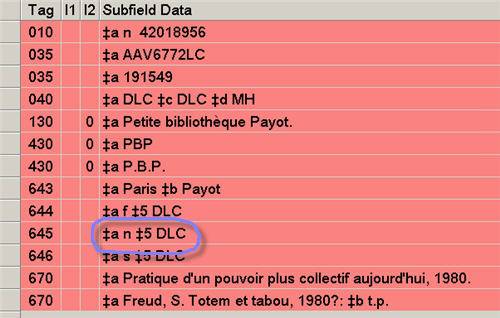
008 for the main series, Petite bibliothèque Payot. The code c is the only indication that the series is numbered.
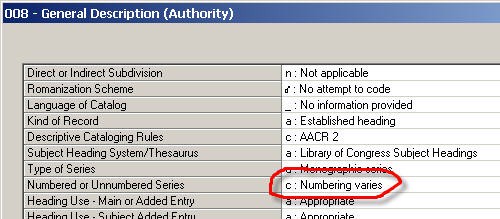
The subseries, on the other hand, is traced and unnumbered.
Variable fields for the subseries. Note that the 645 field indicates the series is traced.
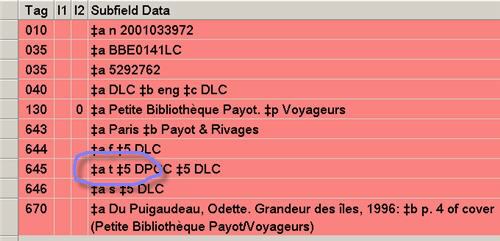
008 for the subseries Petite bibliothèque Payot. Voyageurs.
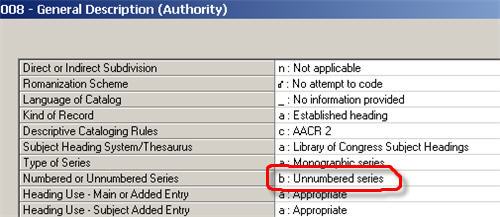
Since the main series is not traced but numbered, and the subseries is traced but not numbered, the standard transcription practice for the 4xx is to enter both series in 490 1 in the form
490 1_ ‡a <main series> ; ‡v <vol. number>. ‡a <subseries>
The subseries is then traced in 830 in the form
830 _0 ‡a <main series>.‡p <subseries>.
Note that the volume numbering is not included in 830, since the numbering is associated with the untraced main series. It may help to look at other bibliographic records that use this particular series/subseries. For complex situations of this kind, it would be a good idea to consult with someone on your team with NACO series experience.
The notes in the cataloging for the source copy apply only to the source copy and are not copied into the record for the translation.
Headings copied from the source record: all 6xx fields. The primary elements of the subject string should match in authority validation. The name of the ship has not been established in Orbis but a name authority record for it exists in OCLC and Library of Congress Authorities. The cataloging is fairly recent, so the assumption is the subdivisions follow current practice. Note that Roslyn Jolly (in the source record) is not associated with the item in hand and her heading is not copied to the record being cataloged.
Two names appear in the statement of responsibility of the translation that do not appear in the cataloging for the source copy: the translator and the author of the introduction. The cataloger needs to consider whether new names in the statement of responsibility justify added entries. The author of a brief introduction does not generally warrant an added entry. A translator is given an added entry only if the work cataloged is belletristic, per LCRI 21.30K1, which is not the case here.



